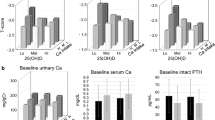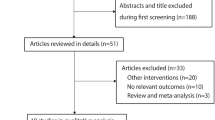Abstract
Eldecalcitol reduces the risk of vertebral fractures in comparison to alfacalcidol in osteoporotic patients under vitamin D repletion. The aim of this study was to evaluate the effects of eldecalcitol on the spinal location of incident vertebral fractures, the severity of the fractures, and the changes in health-related quality of life (HRQOL) compared with those of alfacalcidol. The post hoc analysis has been performed on the data from the three-year, double-blind, randomized, head-to-head clinical trial of eldecalcitol versus alfacalcidol conducted in Japan. A total of 1054 patients were enrolled and randomized to take 0.75 μg eldecalcitol or 1.0 μg alfacalcidol daily for 3 years. The incidence of vertebral fractures was re-evaluated based on the location on the spine (upper T4–T10; lower T11–L4). The severity of vertebral fractures was determined by the semi-quantitative method, and the change in HRQOL was analyzed by using the Medical Outcomes Study Short Form 36-item questionnaire. The incidence of vertebral fracture at the lower spine was less in the eldecalcitol group than in the alfacalcidol group (p = 0.029). The incidence of severe vertebral fracture (Grade 3) was 3.8 % in the eldecalcitol group and 6.7 % in the alfacalcidol group, demonstrated a significant difference between the 2 groups (p = 0.036). Both eldecalcitol and alfacalcidol improved HRQOL in osteoporotic patients. Although no significant differences in each HRQOL scores were observed between eldecalcitol and alfacalcidol during the observational period, overall improvement from baseline of HRQOL scores were clearly observed in the eldecalcitol group. In conclusion, the incidences of lower spinal vertebral fractures and severe vertebral fractures were reduced further by eldecalcitol compared to alfacalcidol in the 3-year clinical trial. Daily treatment with eldecalcitol is effective in improving HRQOL, possibly owing to the reduced risk of lower spinal vertebral fractures and/or severe vertebral fractures.




Similar content being viewed by others
References
Sakuma M, Endo N, Hagino H, Harada A, Matsui Y, Nakano T, Nakamura K (2011) Serum 25-hydroxyvitamin D status in hip and spine-fracture patients in Japan. J Orthop Sci 16:418–423
Papadimitropoulos E, Wells G, Shea B, Gillespie W, Weaver B, Zytaruk N, Cranney A, Adachi J, Tuqwell P, Josse R, Greenwood C, Guyatt G (2002) Meta-analyses of therapies for postmenopausal osteoporosis. VIII: meta-analysis of the efficacy of vitamin D treatment in preventing osteoporosis in postmenopausal women. Endocr Rev 23:560–569
Tilyard MW, Spears GF, Thomson J, Dovey S (1992) Treatment of postmenopausal osteoporosis with calcitriol or calcium. N Engl J Med 326:357–362
O’Donnell S, Moher D, Thomas K, Hanley DA, Cranney A (2008) Systematic review of the benefits and harms of calcitriol and alfacalcidol for fractures and falls. J Bone Miner Metab 26:531–542
Matsumoto T, Ito M, Hayashi Y, Hirota T, Tanigawara Y, Sone T, Fukunaga M, Shiraki M, Nakamura T (2011) A new active vitamin D3 analog, eldecalcitol, prevents the risk of osteoporotic fractures—a randomized, active comparator, double-blind study. Bone 49:605–612
Ito M, Nakamura T, Fukunaga M, Shiraki M, Matsumoto T (2011) Effect of eldecalcitol, an active vitamin D analog, on hip structure and biomechanical properties: 3D assessment by clinical CT. Bone 49:328–334
Oleksik AM, Ewing S, Shen W, van Schoor NM, Lips P (2005) Impact of incident vertebral fractures on health related quality of life (HRQOL) in postmenopausal women with prevalent vertebral fractures. Osteoporos Int 16:861–870
Miyakoshi N, Itoi E, Kobayashi M, Kodama H (2003) Impact of postural deformities and spinal mobility on quality of life in postmenopausal osteoporosis. Osteoporos Int 14:1007–1012
Genant HK, Wu CY, van Kuijk C, Nevitt MC (1993) Vertebral fracture assessment using a semiquantitative technique. J Bone Miner Res 8:1137–1148
Fukunaga M, Nakamura T, Shiraki M, Kuroda T, Ohta H, Hosoi T, Orimo H (2004) Absolute height reduction and percent height ratio of the vertebral body in incident fracture in Japanese women. J Bone Miner Metab 22:104–110
Fukuhara S, Suzukamo Y (2004) Manual of SF-36v2 Japanese version. Institute for Health Outcomes & Process Evaluation Research, Kyoto
Nevitt MC, Ross PD, Palermo L, Musliner T, Genant HK, Thompson DE (1999) Association of prevalent vertebral fractures, bone density, and alendronate treatment with incident vertebral fractures: effect of number and spinal location of fractures. The Fracture Intervention Trial Research Group. Bone 25:613–619
Kado DM, Duong T, Stone KL, Ensrud KE, Nevitt MC, Greendale GA, Cummings SR (2003) Incident vertebral fractures and mortality in older women: a prospective study. Osteoporos Int 14:589–594
Hallberg I, Bachrach-Lindstrom M, Hammerby S, Toss G, Ek AC (2009) Health-related quality of life after vertebral or hip fracture: a seven-year follow-up study. BMC Musculoskelet Disord 10:135
Gallagher JC, Genant HK, Crans GG, Vargas SJ, Krege JH (2005) Teriparatide reduces the fracture risk associated with increasing number and severity of osteoporotic fractures. J Clin Endocrinol Metab 90:1583–1587
Delmas PD, Genant HK, Crans GG, Stock JL, Wong M, Siris E, Adachi JD (2003) Severity of prevalent vertebral fractures and the risk of subsequent vertebral and nonvertebral fractures: results from the MORE trial. Bone 33:522–532
Silverman SL, Minshall ME, Shen W, Harper KD, Xie S (2001) The relationship of health-related quality of life to prevalent and incident vertebral fractures in postmenopausal women with osteoporosis: results from the Multiple Outcomes of Raloxifene Evaluation Study. Arthr Rheum 44:2611–2619
Oleksik A, Lips P, Dawson A, Minshall ME, Shen W, Cooper C, Kanis J (2000) Health-related quality of life in postmenopausal women with low BMD with or without prevalent vertebral fractures. J Bone Miner Res 15:1384–1392
Hagino H, Nakamura T, Fujiwara S, Oeki M, Okano T, Teshima R (2009) Sequential change in quality of life for patients with incident clinical fractures: a prospective study. Osteoporos Int 20:695–702
Salaffi F, Cimmino MA, Malavolta N, Caroti M, Di Matteo L, Scendoni P, Grassi W (2007) The burden of prevalent fractures on health-related quality of life in postmenopausal women with osteoporosis: the IMOF study. J Rheumatol 34:1551–1560
Papaioannou A, Kennedy CC, Ioannidis G, Brown JP, Pathak A, Hanley DA, Josse RG, Sebaldt RJ, Olszynski WP, Tenenhouse A, Murray TM, Petrie A, Goldsmith CH, Adachi JD (2006) Determinants of health-related quality of life in women with vertebral fractures. Osteoporos Int 17:355–363
Iwamoto J, Makita K, Sato Y, Takeda T, Matsumoto H (2010) Alendronate is more effective than elcatonin in improving pain and quality of life in postmenopausal women with osteoporosis. Osteoporos Int 22:2735–2742
Kawate H, Ohnaka K, Adachi M, Kono S, Ikematsu H, Matsuo H, Higuchi K, Takayama T, Takayanagi R (2010) Alendronate improves QOL of postmenopausal women with osteoporosis. Clin Interv Aging 5:123–131
Kushida K, Fukunaga M, Kishimoto H, Shiraki M, Itabashi A, Inoue T, Kaneda K, Morii H, Nawata H, Yamamoto K, Ohashi Y, Orimo H (2004) A comparison of incidences of vertebral fracture in Japanese patients with involutional osteoporosis treated with risedronate and etidronate: a randomized, double-masked trial. J Bone Miner Metab 22:469–478
Yoh K, Tanaka K, Ishikawa A, Ishibashi T, Uchino Y, Sato Y, Tobinaga M, Hasegawa N, Kamae S, Yoshizawa M (2005) Health-related quality of life (HRQOL) in Japanese osteoporotic patients and its improvement by elcatonin treatment. J Bone Miner Metab 23:167–173
Maugeri D, Russo E, Luca S, Leotta C, Mamazza G, Sorace R, Rizzotto M, Manuele S, Fiore V, Taverna G, Castiglia B, Calitro M (2009) Changes of the quality-of-life under the treatment of severe senile osteoporosis with teriparatide. Arch Gerontol Geriatr 49:35–38
Acknowledgments
The present study was sponsored by Chugai Pharmaceutical Co., Ltd. The sponsor of the study participated in the design of the study, data collection, data analyses, data interpretation, and writing of the report. The sponsor supplied the study medication and had responsibility for data collection and quality control. The corresponding author had full access to all the data in the study and had responsibility for the decision to submit for publication. The authors thank all the investigators who participated in the eldecalcitol phase III clinical trial.
Conflict of interest
H. Hagino is a member of an advisory board (Asahi Kasei Pharma, Eli Lilly, Japan) and has received research grants and/or consulting fees (Asahi Kasei Pharma, Astellas, Chugai, Eisai, Eli Lilly, Japan, Mitsubishi Tanabe Pharma, MSD, Ono, Pfizer Japan, Taisho Toyama, Takeda, Teijin Pharma). T. Takano is a fulltime employee of Chugai Pharmaceutical Co., Ltd. M. Fukunaga is a member of an advisory council (Asahi Kasei Pharma, Astellas). M. Shiraki has received consulting fees (Asahi Kasei Pharma, Astellas, Chugai, Daiichi Sankyo, MSD, Teijin Pharma) and lecture fees (Eisai, Ono). T. Nakamura has received research grants and/or consulting fees (Asahi Kasei Pharma, Astellas, Chugai, Daiichi Sankyo, Eisai, Eli Lilly Japan, MSD, Ono, Takeda, Teijin Pharma) and belongs to the Japan Ministry of Health, Welfare and Labor as a councilor for hospital administration and social medical insurance. T. Matsumoto is a member of an advisory board (Lilly) and has received consulting fees (Asahi Kasei Pharma, Astellas, Chugai, Daiichi Sankyo, Ono, Teijin Pharma).
Author information
Authors and Affiliations
Corresponding author
About this article
Cite this article
Hagino, H., Takano, T., Fukunaga, M. et al. Eldecalcitol reduces the risk of severe vertebral fractures and improves the health-related quality of life in patients with osteoporosis. J Bone Miner Metab 31, 183–189 (2013). https://doi.org/10.1007/s00774-012-0397-6
Received:
Accepted:
Published:
Issue Date:
DOI: https://doi.org/10.1007/s00774-012-0397-6




